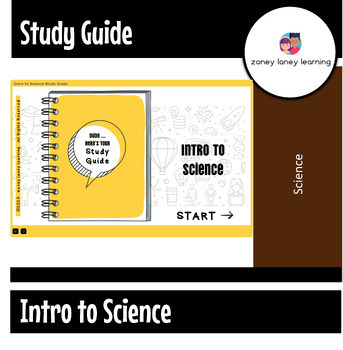Intro to Science DIGITAL Interactive Study Guide & Practice Test TEKS STAAR CCSS
- PDF
- Internet Activities
Description
Dude, here's your study guide ...
Bottom Line Up Front: This is not your typical online study guide!
Not at all ... it's unique. It's interactive. It's engaging and super fun!
Take a peek at the preview version to see for yourself!
This study guide encourages students to own their learning experience through the practical application of knowledge gained from your instruction. It's perfect for pre-test and/or end-of-unit review.
What's It All About?
Learners are presented with a review of general science concepts. Topics include:
- Three Branches of Science
- The Scientific Method
- Data Measurement
- Lab Equipment
- Lab Safety Rules and Guidelines
It's Interactive:
Learners have several opportunities for hands-on application of what they've learned in your class through:
- Crafting well-defined research questions
- Identifying variables
- Writing a hypothesis that can be tested
- Defining SI Units
- Converting metric units
- Interpreting data displayed in graphs and tables
It's Comprehensive:
Learners can confirm understanding throughout the study guide using a variety of methods:
- Multiple-Choice Questions
- Multiple-Select Questions
- Short-Answer Essay Questions
- Hot Spots
- Drag and Drop Interactions
- Text Entry Interactions
- Plotting data on graphs
- Click-to-Reveal Interactions
Basic Features:
- Aligned to TEKS, STAAR, and CCSS (converting metric units).
- Supports Remote Learning: Online module. Internet required.
- Learner Engagement: Encourages critical thinking, immediate application of knowledge, and active learning techniques. Additionally, visual engagement through animation, doodles, and conversational language makes learning fun.
- Bonus Content: Several downloadable study aids are included at no additional cost.
- Glossary: Quick and easy access to the terminology used in the review.
- Unit Test: Learners are presented with a 10-question test as a final opportunity to confirm their understanding of the scientific method and other topics reviewed in the study guide. Learners may print or download test results.
- Automatic scoring and self-correcting answer key. Learners get immediate notification of correct or incorrect responses.
- Retake Option: 10 unit test questions are selected randomly from a pool of over 50 questions. This makes it possible to produce a unique quiz with each retake attempt. In addition, new questions will be added to the pool periodically to keep the pool robust and relevant.
- Personalized: Learners are acknowledged by the name they entered when launching the guide and can download or print any notes they've taken.
- No Prep: Automatic scoring and answer key. Open/send the link and go!
- No macros = open on any device.
- No fuss: A Google account is not required!
- Average duration: 15 - 30 minutes.
What to Expect:
Please use the preview version to test drive before purchasing. This is the best way to understand how the guide works and is also the best way to avoid surprises after purchase.
You'll receive a PDF file with a link to the online guide. This study guide is not editable. While updating the guide periodically, I will do my best to retain the same link. After purchasing, you'll be notified about any updates.
Help Me Get Better:
If you encounter any issues, please get in touch with me at zaneylaneylearning@gmail.com before posting a negative review. I have a lot of ideas, and I'm trying my best to present an error-free, high-quality product. Again, please use the preview version to test drive before purchasing. This is the best way to understand how the guide works and is also the best way to avoid surprises after purchase.
Please let me know if you want additional examples or have suggestions for other uses/topics. Follow me to be the first to know when new products are created.





